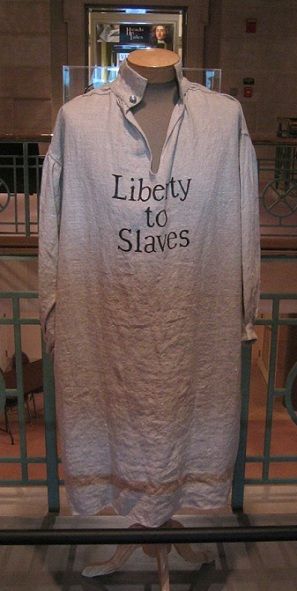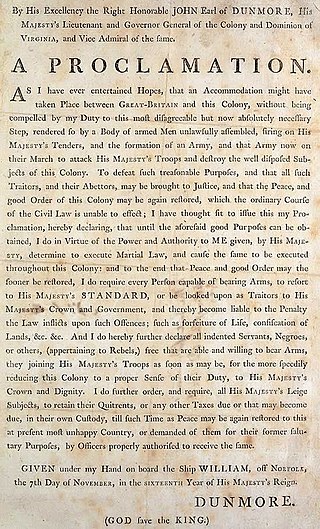
The American Revolutionary War, also known as the Revolutionary War or American War of Independence, was the military conflict of the American Revolution in which American Patriot forces under George Washington's command defeated the British, establishing and securing the independence of the United States. Fighting began on April 19, 1775 at the Battles of Lexington and Concord. The war was formalized and intensified following passage of the Lee Resolution, which asserted that the Thirteen Colonies were "free and independent states", and the Declaration of Independence, drafted by the Committee of Five and written primarily by Thomas Jefferson, by the Second Continental Congress in Philadelphia, on July 2, 1776 and July 4, 1776, respectively.

John Murray, 4th Earl of Dunmore was a British peer, military officer and colonial administrator in the Thirteen Colonies and The Bahamas. He was the last royal governor of Virginia. Dunmore was named governor of New York in 1770. He succeeded to the same position in the colony of Virginia the following year, after the death of Norborne Berkeley, 4th Baron Botetourt. As Virginia's governor, Dunmore directed a series of campaigns against the trans-Appalachian Indians, known as Lord Dunmore's War. He is noted for issuing a 1775 document, Dunmore's Proclamation, offering freedom to any enslaved person who fought for the British Crown against Patriot rebels in Virginia. Dunmore fled to New York after the burning of Norfolk in 1776 and later returned to Britain. He was Governor of the Bahamas from 1787 to 1796.

Titus Cornelius, also known as Titus, Tye, and famously as Colonel Tye, was a slave of African descent in the Province of New Jersey who escaped from his master and fought as a Black Loyalist during the American Revolutionary War; he was known for his leadership and fighting skills. He fought with a volunteer corps of escaped Virginia Colony slaves in the Ethiopian Regiment, and he led the Black Brigade associators. Tye died from tetanus from a musket wound in the wrist following a short siege in September 1780 against Captain Joshua Huddy. He was one of the most feared and effective guerrilla leaders opposing the American patriot forces in central New Jersey.

The Battle of Great Bridge was fought December 9, 1775, in the area of Great Bridge, Virginia, early in the American Revolutionary War. The victory by colonial Virginia militia forces led to the departure of Royal Governor Lord Dunmore and any remaining vestiges of British power over the Colony of Virginia during the early days of the conflict.
Thomas Bullitt was a United States military officer from Prince William County, Virginia and pioneer on its western frontier.

The Gunpowder Incident was a conflict early in the American Revolutionary War between Lord Dunmore, the Royal Governor of the Colony of Virginia, and militia led by Patrick Henry. On April 20, 1775, one day after the Battles of Lexington and Concord, Lord Dunmore ordered the removal of the gunpowder from the magazine in Williamsburg, Virginia to a Royal Navy ship.

Black Loyalists were people of African descent who sided with the Loyalists during the American Revolutionary War. In particular, the term refers to men who escaped enslavement by Patriot masters and served on the Loyalist side because of the Crown's guarantee of freedom.
William Woodford was a Virginia planter and militia officer who distinguished himself in the French and Indian War, and later became general of the 2nd Virginia Regiment in the American Revolutionary War, but was captured at the siege of Charleston, South Carolina and died of disease in New York City about six months later aboard a British prison ship.
The 2d Virginia Regiment was authorized by the Virginia Convention, July 17, 1775, as a force of regular troops for the Commonwealth's defense. It consisted of seven companies, 476 privates and the usual regimental officers. William Woodford, of Caroline County, named colonel, along with Lieutenant Colonel Charles Scott and Major Alexander Spotswood were the regiment's initial field officers. Virginia had been divided into 16 military districts which took their names from the predominant county in the grouping; for instance, Prince William District included Fairfax and Loudoun Counties as well. Col. Gregory Smith 1777-78 Col Brent 1779

The southern theater of the American Revolutionary War was the central theater of military operations in the second half of the American Revolutionary War, 1778–1781. It encompassed engagements primarily in Virginia, Georgia and South Carolina. Tactics consisted of both strategic battles and guerrilla warfare.

The history of Virginia Beach, Virginia, goes back to the Native Americans who lived in the area for thousands of years before the English colonists landed at Cape Henry in April 1607 and established their first permanent settlement at Jamestown a few weeks later. The Colonial Virginia period extended until 1776 and the American Revolution, and the area has been part of the Commonwealth of Virginia ever since.
Kempsville is a borough in the City of Virginia Beach, Virginia, a historic section with origins in US colonial times located in the former Princess Anne County. In modern times, it is a community within the urbanized portion of the independent city of Virginia Beach, the largest city in Virginia.

"Give me liberty, or give me death!" is a quotation attributed to American politician and orator Patrick Henry from a speech he made to the Second Virginia Convention on March 23, 1775, at St. John's Church in Richmond, Virginia. Henry is credited with having swung the balance in convincing the convention to pass a resolution delivering Virginian troops for the Revolutionary War. Among the delegates to the convention were future United States presidents Thomas Jefferson and George Washington.

Dunmore's Proclamation is a historical document signed on November 7, 1775, by John Murray, 4th Earl of Dunmore, royal governor of the British colony of Virginia. The proclamation declared martial law and promised freedom for slaves of American Patriots who left their owners and joined the British army, becoming Black Loyalists. The same right was offered to indentured servants. Most relevant historians agree that the proclamation was chiefly designed for practical rather than moral reasons.

In the American Revolution, gaining freedom was the strongest motive for Black enslaved people who joined the Patriot or British armies. It is estimated that 20,000 African Americans joined the British cause, which promised freedom to enslaved people, as Black Loyalists. Around 9,000 African Americans became Black Patriots.
The Ethiopian Regiment, better known as Lord Dunmore's Ethiopian Regiment, was a British colonial military unit organized during the American Revolution by the Earl of Dunmore, last Royal Governor of Virginia. Composed of former slaves who had escaped from Patriot masters, it was led by British officers and sergeants. The regiment was disbanded in 1776, though many of its soldiers probably went on to serve in other Black Loyalist units.

The Burning of Norfolk was an incident that occurred on January 1, 1776, during the American Revolutionary War. British Royal Navy ships in the harbor of Norfolk, Virginia, began shelling the town, and landing parties came ashore to burn specific properties. The town, whose significantly Tory (Loyalist) population had fled, was occupied by Whig (Revolutionary) forces from Virginia and North Carolina. Although these forces worked to drive off the landing parties, they did nothing to impede the progress of the flames, and began burning and looting Tory properties.

The history of Virginia in the American Revolution begins with the role the Colony of Virginia played in early dissent against the British government and culminates with the defeat of General Cornwallis by the allied forces at the Siege of Yorktown in 1781, an event signaled the effective military end to the conflict. Numerous Virginians played key roles in the Revolution, including George Washington, Patrick Henry, and Thomas Jefferson.
The following is a timeline of the history of the city of Virginia Beach, Virginia, USA.
The Battle of Gwynn's Island saw Andrew Lewis lead patriot soldiers from Virginia against John Murray, 4th Earl of Dunmore's small naval squadron and British loyalist troops. In this American Revolutionary War action, accurate cannonfire from the nearby Virginia mainland persuaded Dunmore to abandon his base at Gwynn's Island. While camping on the island, the loyalists suffered heavy mortality from smallpox and an unknown fever, particularly among the escaped slaves that Dunmore recruited to fight against the American rebels. Gwynn's Island is located on the western shore of Chesapeake Bay in Mathews County, Virginia.















